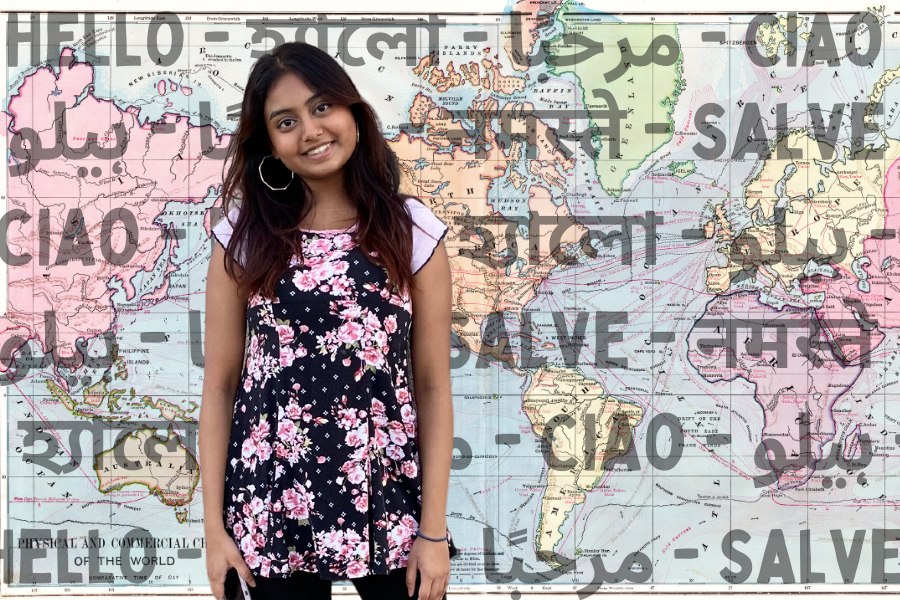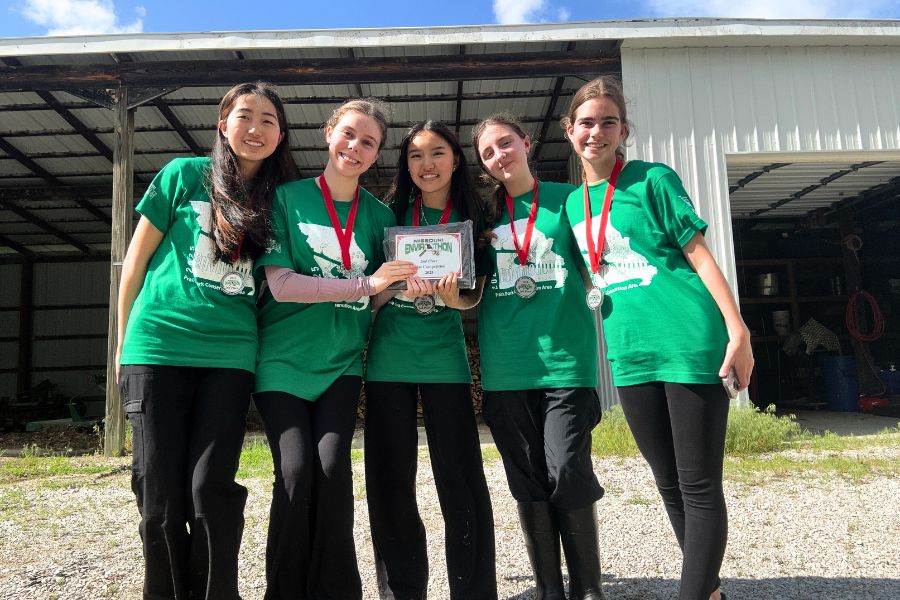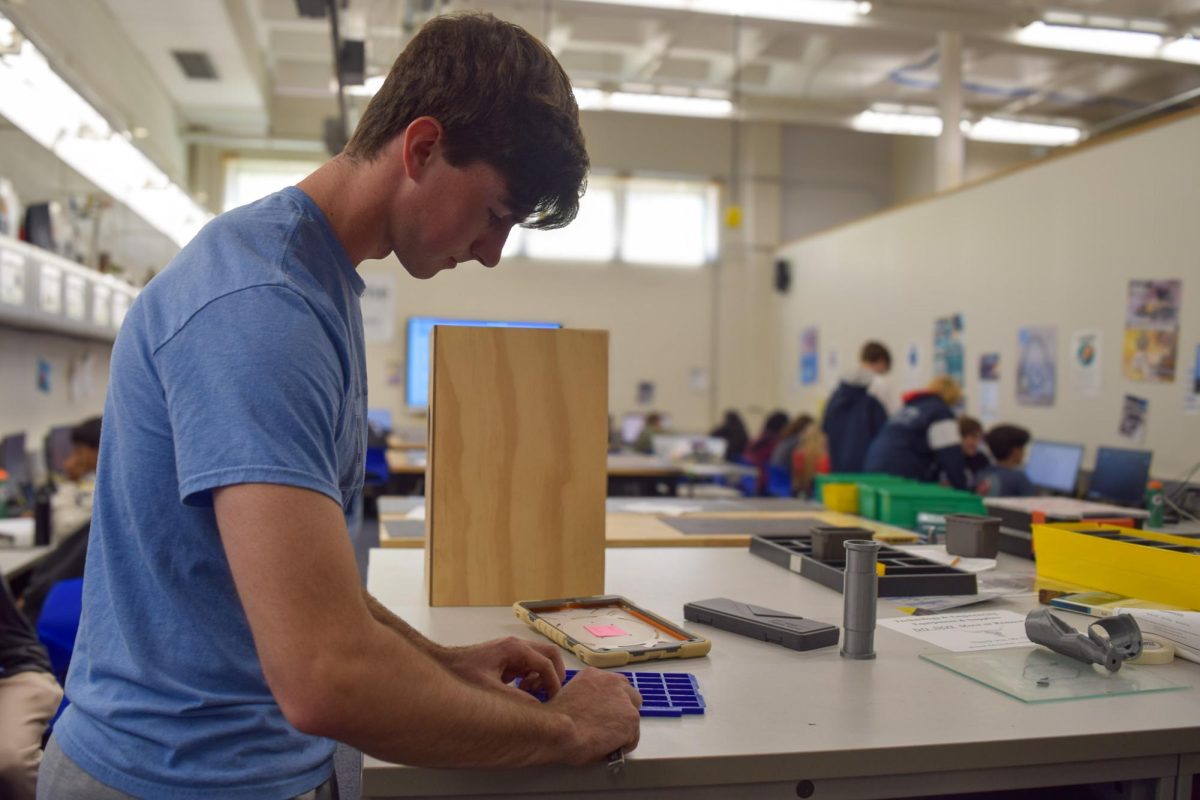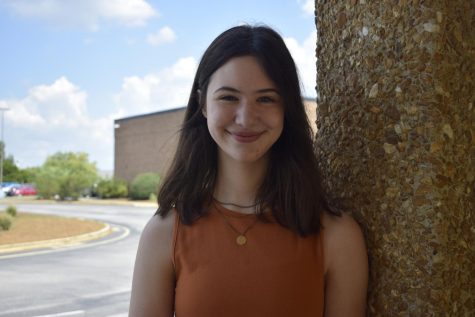Walking through the halls, hundreds of conversations in English surround junior Suraiya Saroar, though her mind goes from language to language. As a friend catches up to her to chat, she replies with an automatic English response. However, despite the English coming out of her mouth, languages from around the globe continue to bounce around in her brain.
Only 3% of the world’s population are polyglots — people who speak a multitude of languages — including Saroar, who speaks Hindi, Urdu, Arabic, English and Bangla, her first language and the official language of her birth country, Bangladesh.
“Bangla will always be the [language] I consider most important. It’s the one that I prioritize knowing the best. I can learn about English and Hindi, but I want to make sure I stay fluent in Bangla,” Saroar said. “[Speaking it is] being immersed in [my] culture. It’s my life, and I’m proud to say I can speak [Bangla] natively.”
After moving to the United States at age 5, Saroar entered kindergarten knowing only a few words in English. Before going to school each morning, Saroar watched English television shows such as “Dora the Explorer” to learn the language better.
“At school, it was hard because the other kids didn’t know that I [did not] speak English. I wanted to be a part of the [kids’] conversations, but I didn’t know what they were saying. So, no matter what they were saying, I would say, ‘I like Dora,’” Saroar said. “I couldn’t speak with everyone, but I wanted to be included. So I tried harder to learn.”
After being immersed in an English-speaking environment for most of her life, Saroar now speaks fluent English at school and with her peers, but she still speaks Bangla almost exclusively at home.
“Some words I know in Bangla I don’t know in English and [vice versa]. [Sometimes] I’m trying to explain to my parents one thing that happened to me at school, but I’m like, ‘how do I explain it to them properly without using English?’” Saroar said. “It does take a lot of practice and trial and error to learn another language. You have to be able to be wrong. You [can’t] be afraid to ask questions. [After learning a language], you’re not as afraid to ask questions later in life.”
Instead of using ordinary language learning apps like Duolingo or Babbel, Saroar’s learning of new languages consists of exposure to her target language through media such as television shows and movies and conversing with native speakers.
“You can learn slang from a native [speaker] that you can’t learn from an app. I just find it easier to learn from a native speaker because they know the rules of the language,” Saroar said.
Saroar also is learning Latin and immersing herself in the language through her Latin 3 class. In addition, she is learning Italian through relatives to communicate with them. Saroar finds that when she discovers a language, she learns about the language itself and the culture of the people who speak that language.
“I have a bigger knowledge of different cultures around the world. [I have] respect for the people who speak them and respect for other languages, especially because [some languages] are hard. [Still], some people can learn it quickly or speak it fluently. Languages are just naturally very beautiful, like Arabic. I love being able to speak it and read it because it’s such a beautiful language,” Saroar said.
Click on the interactive image to listen to junior Suraiya Saroar introduce the language she is speaking and say “how are you?”Despite learning many languages throughout childhood, Saroar has found it harder to learn languages as she grows up. However, this experience is common to Saroar, as learning a language during childhood can be much easier.
“I persist [learning new languages] because I enjoy learning [them]. I feel like it’s part of my personality, so I love learning more. I’m also naturally curious, so I learn languages to satisfy that curiosity,” Saroar said.
Saroar tries to help others facing language barriers, and though she’s now too busy to do it, she has taught kids English. In addition, Saroar currently helps her brother learn Bangla and teaches her friends if they ask.
“It makes me happy to be able to help people, especially when they’re struggling [with a language barrier]. It hits close to home because when we first moved here, my mom and I had the same problem: we couldn’t express ourselves. There was never really anyone to help [us], so it makes me feel better to help others in that situation because I know what it feels like,” Saroar said. “If someone was trying to learn Bangla, and they’re saying something in a weird accent, I would never judge them. They are putting in the effort, and that’s commendable. They’re trying hard, doing it [and] that’s better than most people can do.”
Saroar plans to continue learning languages while furthering her education and fluency in the languages she already speaks.
“I grew up learning a lot of languages, and I always loved feeling like part of a community. It’s cool to learn about the culture. [When you are learning a language], you learn a lot about where the language comes from,” Saroar said. “Learning other languages teaches you compassion, not just for the language you speak, but for people in general.”



![Focused on providing exceptional service, sophomore Darsh Mahapatra carefully cleans the door of a customer’s car. Mahapatra has always believed his customers deserve nothing less than the best. “[If] they’re trusting us with their car and our service, then I am convinced that they deserve our 100 percent effort and beyond,” Mahapatra said.](https://pwestpathfinder.com/wp-content/uploads/2025/10/DSC_0018-1200x800.jpg)
![Sophomore Aleix Pi de Cabanyes Navarro (left) finishes up a soccer game while junior Ava Muench (right) warms up for cross country practice. The two came to Parkway West High School as exchange students for the 2025-2026 school year. “The goal for the [exchange] program is to provide opportunities for both Parkway students and our international exchange students to learn about other cultures, build connections and become confident, capable, curious and caring — Parkway’s Four C’s — in the process,” Exchange Program Lead Lauren Farrelly said.](https://pwestpathfinder.com/wp-content/uploads/2025/10/Feature-Photo-1200x800.png)

![Gazing across the stage, sophomore Alexis Monteleone performs in the school theater. The Monteleone family’s band “Monte and the Machine” has been releasing music since 2012, but Alexis started her own solo career in 2024 with the release of her first single, Crying Skies. “My whole family is very musical, [and I especially] love writing [songs with them],” Monteleone said.](https://pwestpathfinder.com/wp-content/uploads/2025/09/DSC7463-1200x798.jpg)
![Amid teaching a lesson to her AP Calculus BC class, Kristin Judd jokes alongside her students in their funny remarks. Judd has always enjoyed keeping the mood light in her classroom, along with on the volleyball court. “[I enjoy] that side talk where you see [or] overhear a conversation and chime in, or somebody says something funny,” Judd said.](https://pwestpathfinder.com/wp-content/uploads/2025/09/image-1200x730.jpg)
![Eyeing the ball, junior Ella McNeal poses for her commitment pictures at Clemson University. McNeal’s commitment comes after months of contact with top Division 1 soccer programs. “ It has taken a lot to get to where I am, but I know that [what] I've already been through is just the beginning, and I can't wait for what is to come,” McNeal said.](https://pwestpathfinder.com/wp-content/uploads/2025/09/IMG_4926-1200x900.jpeg)


![Senior Adam Zerega stands with senior Dexter Brooks by farm equipment. Zerega often worked with friends and family on his farm. “I've been able to go to my family's farm since I was born. I [spend] at least three weekends a month [on the farm], so I'm there all the time,” Zerega said.](https://pwestpathfinder.com/wp-content/uploads/2025/04/IMG_4872-1200x900.jpg)

![Leaning on the podium, superintendent Melissa Schneider speaks to Parkway journalism students during a press conference. Schneider joined Parkway in July after working in the Thompson School District in Colorado. “My plan [to bond with students] is to get things on my calendar as much as possible. For example, being in [classes] is very special to me. I am trying to be opportunistic [meeting] kids [and] being in [the school] buildings. I have all the sports schedules and the fine arts schedules on my calendar, so that when I'm available, I can get to them,” Schneider said.](https://pwestpathfinder.com/wp-content/uploads/2025/09/IMG_5425-1200x943.jpeg)

![Leaping through the air, senior Tyler Watts celebrates his first goal of the season, which put the Longhorns up 1-0 against the Lafayette Lancers. Watts decided to play soccer for West for his last year of high school and secured a spot on the varsity roster. “[Playing soccer for West] is something I had always dreamed of, but hadn’t really had a good opportunity to do until now. It’s [really] fun being out [on the field], and I’m glad I decided to join the team. It’s just all about having fun with the boys and enjoying what time we have left together,” Watts said.](https://pwestpathfinder.com/wp-content/uploads/2025/09/DSC_1951-1200x855.jpg)

![Junior Fiona Dye lifts weights in Strength and Conditioning. Now that the Trump administration has instituted policies such as AI deregulation, tariffs and university funding freezes, women may have to work twice as hard to get half as far. "[Trump] wants America to be more divided; he wants to inspire hatred in people,” feminist club member and junior Clara Lazarini said.](https://pwestpathfinder.com/wp-content/uploads/2025/05/Flag.png)
![As the Trump administration cracks down on immigration, it scapegoats many immigrants for the United States’ plights, precipitating a possible genocide. Sophomore Annabella Whiteley moved from the United Kingdom when she was eight. “It’s pretty scary because I’m on a visa. When my visa expires next year, I’m not sure what’s going to happen, especially with [immigration] policies up in the air, so it is a concern for my family,” Whiteley said.](https://pwestpathfinder.com/wp-content/uploads/2025/05/DSC_0077-7copy.jpg)
![Shifting global trade, President Donald Trump’s tariffs are raising concerns about economic stability for the U.S. and other countries alike. “[The tariffs are] going to pose a distinct challenge to the U.S. economy and a challenge to the global economy on the whole because it's going to greatly upset who trades with who and where resources and products are going to come from,” social studies teacher Melvin Trotier said.](https://pwestpathfinder.com/wp-content/uploads/2025/05/MDB_3456-1200x800.jpg)

![Pitching the ball on Apr. 14, senior Henry Wild and his team play against Belleville East. Wild was named scholar athlete of the year by St. Louis Post-Dispatch after maintaining a high cumulative GPA and staying involved with athletics for all of high school. “It’s an amazing honor. I feel very blessed to have the opportunity to represent my school [and] what [it] stands for,” Wild said.](https://pwestpathfinder.com/wp-content/uploads/2025/05/unnamed-6-1200x714.jpg)
![Red, white and blue, the American flag holds the values of our democracy. The fight that we once endured has returned, as student journalists and senior correspondents across the country are losing their voices due to government control. “[Are] the White House and [the] government limiting free speech [and] freedom of the press? Yes [they are],” chief communications officer of the Parkway School District and former journalist Elisa Tomich said.](https://pwestpathfinder.com/wp-content/uploads/2025/03/Untitled-design-14.jpg)

Serena • Mar 14, 2023 at 5:29 pm
Great story Anna! Suraiya is awesome.